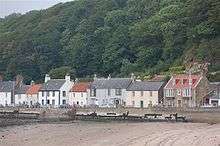Limekilns


Limekilns, a village in Fife, Scotland, lies on the shore of the Firth of Forth.[1][2] Population 1,430 (est. in 2008). Unlike the neighbouring village of Charlestown, Limekilns is an old settlement dating back to the 14th century.[2] The oldest building in the village is The King's Cellar, a large and mysterious property existence of which can be traced back to 1362. It has served many different purposes throughout its long life, notably as a store house, school, library and chapel. It is currently employed as a Freemasons Lodge and is generally not open to the public.
The exact origins of the name Limekilns are unknown. Certainly lime was burned there in relatively small amounts in the early life of the village, though there was a much larger operation going on in the neighbouring village of Charlestown. The ruins of the massive kilns still exist today and are protected by the National Trust for Scotland.
In its early days Limekilns was mainly a fishing village, with the large natural harbour providing docking facilities for small to medium transport and cargo ships. For many centuries Limekilns was also the northern terminus for a ferry linking it to Bo'ness on the southern side of the Forth. This found an echo in Robert Louis Stevenson's Kidnapped: and it was from Limekilns that David Balfour and Alan Breck were carried across the Forth in a rowing boat. Soap was also produced from a soapworks located near Caupernaum Pier. The years of industrial decline meant that most of these industries were lost and Limekilns became just another sleepy coastal village. New housing estates were added during the property boom of the 1970s and 1980s, considerably boosting the size and population of the village. The Limekilns Hotel & Bistro provides accommodation and food.
Limekilns is presided over by the Earl of Elgin, who lives in Broomhall House overlooking the village. The Earls of Elgin owned land in the Crossford area in connection with the Elgin Colliery (at Parkneuk and Baldridge Burn, NW of Dunfermline) and the Elgin Railway that ran from the Colliery round Crossford and then down beside Waggon Road and on to Charlestown harbour. The route of the railway and the site of the Elgin Colliery are shown in a map in Chalmers' book, Historical and Statistical Account of Dunfermline.
To the north, paths run via Pitliver to Crossford and through the estate of the Earl of Elgin and Wester Gellet to Pittencrieff Park at Dunfermline.
Limekilns is the birthplace of George Thomson.
References
- ↑ Ordnance Survey: Landranger map sheet 65 Falkirk & Linlithgow (Dunfermline) (Map). Ordnance Survey. 2012. ISBN 9780319229705.
- 1 2 "Gazetteer for Scotland: Limekilns". www.scottish-places.info. Retrieved 7 April 2016.
| Wikimedia Commons has media related to Limekilns. |
Coordinates: 56°02′N 3°28′W / 56.033°N 3.467°W